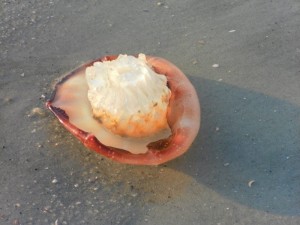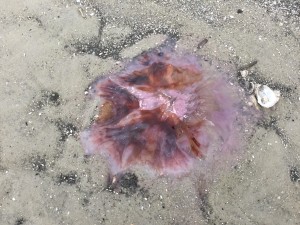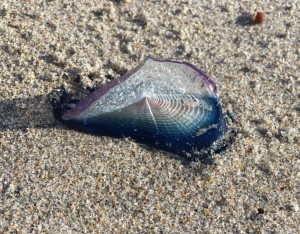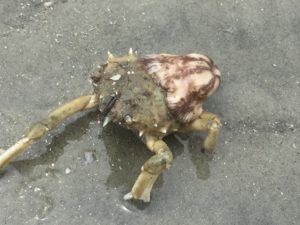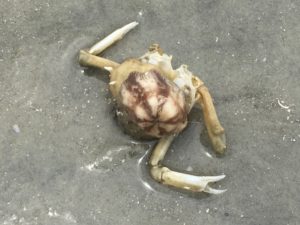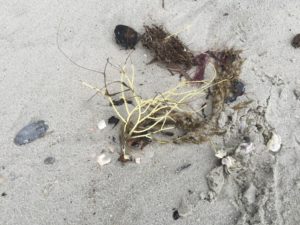Cnidarians, of the phylum Cnidaria, includes jellyfish, hydrozoans, anemones, and corals. Cnidarians are characterized by the presence of minute stinging cells, and by their radial symmetry, or circular body design. Cnidarians may have a free-living medusa phase (like a jellyfish), a polyp stage (fixed like an anemone), or both, during their life cycle.
Scyphozoans, Jellyfish or Jellies are free living individual creatures with multiple tentacles and a circular bell. A group of jellies is called a smack, but also a bloom or swarm when they are super abundant in midsummer. Not all varieties sting, but it is always better to play it safe and not touch or step on them (if you can help it).
- Cannonball jellies are the ones most commonly seen beached on HHI. Cannonballs lack true stinging tentacles, although some people report skin irritation with contact.
- The cannonballs can actually be quite pretty when freshly beached. The body is translucent, allowing the reddish internal organs to be seen.
- Beached jellies get pounded by the surf until only the toughest bits remain. This is the mouth cylinder of a cannonball jelly.
- Moon Jellies have a saucer-like bell and are translucent allowing four lobe-shaped gonads to be seen. Moon Jellies have hundreds of short tentacles and do have a mild sting.
- Here you can see the rusty radiating stripes that distinguish the Sea Nettle. The margin of the bell is notched, with 2 or 3 tentacles between each notch.that are several feet long The arms around the mouth have frilly edges. The Sea Nettle can deliver severe blistering stings, even when dead.
- The bay (sound) form lacks the stripes and is milky white.
- Pigmentation can vary from milky white to red, brown, and purple.
- Some remaining long tentacles can be observed here.
The first video is of a Sea Nettle swimming just off the shore. They are beautiful to watch, but remember that the stinging tentacles are several feet long, so keep your distance. The second video is of a live cannonball jelly in a tidal pool.
Hydrozoans may be free living like the Portuguese man o’war, or may be sessile, or stationary, like the bushy hydroids.
 The Portuguese man o’war is a fairly large, oblong, translucent, gas-filled float that is tinged with blue, pink, and/or purple. The upper surface of the float has a wing-like flange to allow movement over the water surface by the wind. The tentacles are very long, (up to 165 feet!!). but are usually broken off when beached. The man o’war is not a jellyfish, but a colony of many zooides specialized for feeding, defense, etc. The sting is very toxic and medical attention should be sought if stung. If you find one on the beach, please be very careful and DO NOT TOUCH as the tentacles continue to be active, even after being beached.
The Portuguese man o’war is a fairly large, oblong, translucent, gas-filled float that is tinged with blue, pink, and/or purple. The upper surface of the float has a wing-like flange to allow movement over the water surface by the wind. The tentacles are very long, (up to 165 feet!!). but are usually broken off when beached. The man o’war is not a jellyfish, but a colony of many zooides specialized for feeding, defense, etc. The sting is very toxic and medical attention should be sought if stung. If you find one on the beach, please be very careful and DO NOT TOUCH as the tentacles continue to be active, even after being beached.
- This is a Velella Velella, or more commonly, a By The Wind Sailor. They are much like the man o’war, but much smaller and only mildly toxic,
- but care should still be taken.
Bushy hydroids grow as delicate, feathery stems resembling seaweed from a basal stolon. Hydroids are a sessile colony of animals, the stems containing numerous polyps with microscopic tentacles. The colonies may be found attached to jetties, docks, and pilings, in addition to the hard bottom of the sea floor. Care is required in handling because hydroids may cause minor skin irritation because of the stinging cells in the polyps.
Anthozoans, including Anemones and Corals, are often sessile (stationary) and colonial, but some kinds, such as anemones, lead a solitary life and can move as necessary. Anthozoans do not have a medusa (jellyfish like) stage in their life cycle.
Anemones are flower-like creatures with multiple tentacles. Anemones do not usually live in colonies. Below is a Warty Anemone on a rock jetty. These anemones are green, orange, or brown and have rows of wart-like bumps on their column, the area between the base and tentacles which is not pictured here. Many short tentacles surround the mouth. The warty anemone live in fairly shallow water, clinging to rock jetties or other hard surfaces. The species is very motile and can contract itself tightly to survive emergence at low tide or if otherwise disturbed. It resembles a dark, gelatinous substance when retracted- see the image below on the right.
- A Warty Sea Anemone on a rock jetty.
- Warty Sea Anemone retracted.
Hermit, Hitchhiker, or Tricolored Anemones are a tan to pink thimble or disk shape, often mottled or with dark bands or stripes. The many tentacles may appear banded and are usually white, but may also be pink or orange. This anemone is often found attached to other organisms, such as the hydroid seen above, or the spider crab seen below, giving it the common name hitchhiker anemone. It also has the common name hermit anemone, because it also often clings to hermit crabs. The anemone will form a symbiotic relationship with the hermit crab where it will eat the remnants of the hermit crabs meals, thus keeping things tidy for the crab. It is capable of switching from one shell to another, either on its own, or under the direction of the hermit crab.
- Color banding seen here.
- The tentacles, although partially retracted, are visible here.
- Attached to a spider crab.
- Another view.
Corals are flower-like animals with 6 or 8 tentacles, often with a stiff interior skeleton. Corals are a colony of individual animals, each coral polyp residing in one of the pits of the larger calcium structure. The body is a small tube permanently attached to its home on one end, with a tentacle surrounded mouth on the other. The tentacles extend from the pit to trap food. Each coral polyp secretes its own pit and foundation made of calcium carbonate, joining with adjacent polyps to form the skeleton of the colony. Corals may be oft (flexible), or hard/stony (like rocks).
Colorful Sea Whups are a soft coral commonly found on the island. The stems are sparsely branched near the base and covered in small pores from which the polyps emerge when alive. The stems are cyndrical and grow whip or brush-like, in red, purple, pink, yellow, orange, white or combinations in between. The colony attaches by a holdfast to some hard surface. Beached specimens will often have the colorful tissue worn away, exposing the woodlike stem/skeleton beneath.
- A beautiful specimen cleaned and ready for display.
- An orange specimen much eroded to show the woody skeleton.
- To the left,a yellow, white, and pink specimens tangled with the remains of a marine plant. A pink specimen above.
- Pink and yellow specimens tangle with brown algae (seaweed) and an encrusting sponge or bryozoan.
- A yellow specimen tangles with red and brown algae (seaweed). The pores are very evident here.
A Sea Pansy is a leaf or heart shaped frond bearing white polyps on the upper surface in life, with a bare stem-like stalk underneath. the color can vary from light pink to dark violet. Unlike other coral that anchor on a hard surface, sea pansies anchor on soft, sandy ocean floor. The colony has the ability to inflate and deflate by pumping water through the pore-like polyps. Unlike the other soft corals, sea pansies lack a woody stem under the surface.
Stony or Hard Corals
- The Northern Sea Star forms spherical or encrusting colonies with compact, circular pits, with little to no space in between. The Northern Sea Star is found much farther north than any other stony coral and is the most common stony coral found on our beaches.
- Due to the color and shape, I originally thought this (left) was an Ivory Tree Coral, but further research leads me to believe it is a bleached piece of a Giant Sea Fingers coral. The Ivory Tree Coral is quite small and covered in distinct pits, while this coral is large and sturdy with small pores instead of distinct pits. The smaller specimens on the right are fossils from a creek bed in Ohio, area once covered by ocean.


